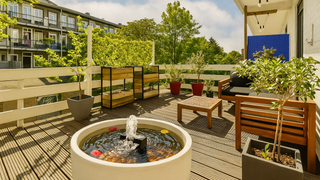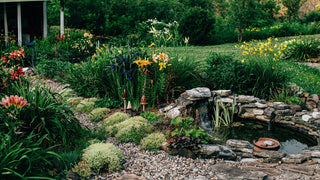
You've found the perfect outdoor fountain for your garden — maybe a small birdbath, a wobbly basin, or a giant multi-level spectacular — but now you're stumped: How do I figure out what size of fountain pump to buy?
Picking the appropriate pump size is not merely a matter of how much water you like to pump. It decides your fountain's tone, its efficiency, and how long your pump will survive. Choose one that is too small, and your water drips pitifully. Choose one that is too large, and you've got splashing, noise, and wasted power.
In this expert manual, we will guide you through learning how to size a fountain pump correctly, reading specs confidently, and getting the proper fit using Poposoap solar fountain technology renowned for its symbiosis between flow, energy efficiency, and durability.
Why Pump Size Matters for a Fountain
The pump of a fountain is its core. It controls how much water flows, how high it spurts, and how well the system functions.
- Too small a pump: Water will hardly flow at all, producing stagnation, algae, and pump stress.
- Too big a pump: Water will splash over the edges, producing evaporation and energy loss.
The correct size keeps the fountain's water flowing smoothly, is less noisy, and protects your motor and fountain equipment. Poposoap solar pumps provide smooth flow with only the right pressure and quietness.
How to Select the Proper Fountain Pump Size
When "How do I choose what size fountain pump to buy?" is asked, the answer depends on two main considerations: fountain volume and desired water height or flow pattern.
Step 1 — Find the Water Volume

Approximate the water volume in your fountain. You can figure it out by multiplying the length × width × depth of the basin, then divide by 7.5 to get gallons (1 cubic foot = 7.5 gallons).
- Small tabletop or bird bath fountains: 50 gallons or less → use a 50–90 GPH pump.
- Medium-sized garden fountains: 50–150 gallons → use a 100–250 GPH pump.
- Large ponds or tiered fountains: 200+ gallons → 300 GPH or more.
Solar units like Poposoap solar fountain pumps already have the flow rate (GPH) and height adjusted for specific garden sizes — making sizing easier without electrical math.
Step 2 — Determine the Lift Height

The lift height (or head height) is how high the pump can push water vertically. The higher your fountain, the more lift you’ll need.
As a rule of thumb:
- For every foot of fountain height, add 1 foot of lift capacity to your pump's demand.
- If your fountain is 3 feet tall, choose a pump with at least 4 feet of lift capacity.
Poposoap solar pumps also indicate the maximum height of lift in the user manual so you can choose the correct model for your building.
Step 3 — Decide on the Type of Water Flow You Want

Do you want a soft ripple, bubbling brook, or high-pressure jet spray?
- Soft bubbling: Low head pumps 2–6W solar pumps are ideal.
- Tiered or cascading flows: Synchronous water flow from tiers is delivered by 8–10W units.
- Pond aeration or powerful jets: 12W and above models create beautiful, ornamental sprays.
The more theatrical the effect, the greater the power — but make sure it's appropriate for your fountain size to avoid splashing.
How to Read Fountain Pump Specs
Knowing the specs of a pump allows you to compare models wisely. Here's what to search for:
- GPH (Gallons Per Hour): Amount of water the pump transports. Higher GPH = more flow.
- Lift Height (Head): Maximum vertical distance water can be pumped.
- Wattage: Power rating — higher wattage produces more powerful flow but uses more energy.
- Cord Length: How far the panel is from the pump (particularly crucial for solar setups).
- Panel Style: Monocrystalline solar panels, which are employed in Poposoap systems, perform better in low light.
In solar models, highlight wattage and height rather than electric current since power is tapped directly from sunlight.
Common Mistakes in Choosing a Fountain Pump
Even experienced gardeners make pumping blunders which have the effect of minimizing the life of their fountain pump. These are the most frequent ones:
- Not making the pump large enough. The sagging pump simply won't pump the water, resulting in algae and burnout.
- Not taking lift height into account. Tall fountains need more pressure than low birdbaths.
- Installing an oversized pump. Too much flow spills water, wastes water, and makes a racket.
- Forgetting filtration. Without a filter box, dirt and debris will gum up the motor.
- Shading the solar panel. Even partial shade can cut the pump's power in half.
Poposoap's solar pumps are designed with adjustable flow control and built-in filtration, keeping such issues in check while ensuring proper energy balance.
Tips for Best Fountain Performance
Having chosen the ideal fountain pump size, maintenance keeps it in top performance:
- Empty filters every week to prevent clogging and water resistance.
- Monitor water levels daily during hot weather to prevent drying out the pump.
- Have solar panels facing direct sunlight for best output.
- Clean panels from time to time to prevent dust and dirt accumulation.
- Cap with filtered or rainwater instead of hard tap water to reduce mineral deposit buildup.
Poposoap solar pumps feature removable filters and brushless motors that make maintenance easy with fast, hassle-free cleaning — no tools needed.

FAQ — Fountain Pump Size & Flow Rate
Q1: How big of a pump do I require for my fountain?
Use your fountain's volume of water and height reading. Choose a pump that circulates the full volume of water at least once per hour and has enough head to your fountain's top.
Q2: What if my pump is too powerful?
You can reduce flow with the adjustable nozzle provided with most Poposoap pumps.
Q3: How do I apply a water fountain pump size calculator?
Calculate your basin's dimensions multiplied together to find its volume and couple it with the same GPH rating.
Q4: What is the optimal size for a small garden fountain?
Ideal size for birdbaths or small bowls is a small 6–8W solar pump.
Q5: When do I replace my pump?
If water flow remains sluggish even after cleaning and good sunlight exposure, maybe it's time to upgrade.
Conclusion — The Right Size Makes All the Difference
Selecting the appropriate fountain pump size ensures effective, quiet, and smooth operation of your water feature. Once you know your fountain size and desired water flow, you can easily match it.
Poposoap solar fountain pumps perform for any size garden — from the smallest birdbaths to the largest tiered fountains — with solar performance, silent running, and adjustable power for the ideal flow every time. With the correct pump, your fountain will be free-flowing, in balance, and resplendent year after year.







